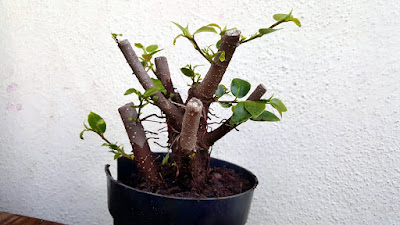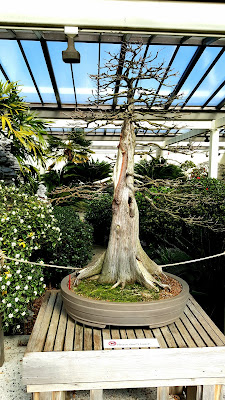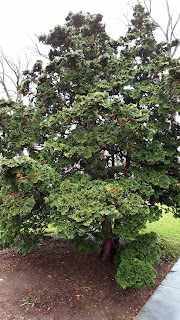Epiphytes are plants that start their lives on top of
something that is not the ground. Most commonly they grow on top of other
trees. I have seen some grow on cracks in walls and on freeway overpasses. You
might be familiar with orchids, bromeliads, and tillandsia all of which are
epiphytes. This post will be about Ficus microcarpa, or the Chinese banyan
tree. Fig trees are known the world over
as strangler trees. A bird eats a fig, and then poops on a tree. Some seeds
germinate. The plants get their nourishment and water from moisture and dirt
that collects in the crevices where it grows. They are not parasitic organisms. These plants will slowly grow a root down the tree until it
touches the ground. When this happens the epiphytes growth explodes surpassing
the growth of the host tree. Eventually the epiphytic Ficus will shade the host
tree weakening it. The host tree eventually dies leaving the Ficus.
Here in sunny southern California we do not get a lot of
rain. This keeps the epiphytic Ficus from getting to a relatively large size. The
exception is this massive palm tree growing in the crotch of this blood tree.
 |
| This is not photoshop |
My office faces this Italian stone pine. I have worked in my office for
thirteen years. The grounds keepers will cut and poison this Ficus every other
year. The branches are long and slender from last year’s growth. The trunk however
is thick and covered in scars. I do not harvest this Ficus because the plant
has wedged itself between the trunks and has an amoeba like shape, and that is
no bueno.
 |
| See the pruning shears? |
This is my favorite cutting tool for collecting these Ficus. It’s a Gerber saw, and it works great. Later
on you will see how straight this saw cuts.
 |
| Great tool |
This is the prize of the day. I noticed it last year. It is
a Ficus microcarpa var. green mound. The leaves grow oval and dark green. It
really is a beautiful tree. I had collected some of its branches last year.
They are all doing great. Now that we have hot weather again I decided to
collect this tree. Now, I call the Ficus the Lazarus tree because it is very
hard to kill. I have had Ficus that I have left for dead, I stopped watering them. After it rains some months later they start sprouting green buds. I collected
a ficus that was growing on a sheer granite face. It boggles me as to how it
survived on smooth granite. I wonder what it clung on to. I removed it and took
it home. All the leaves fell, the branches dried. I put it to the side to
discard later and forgot all about it. Months later after a rain storm I saw
green buds growing. It was amazing. I was going to throw it away.


Anywho, back to business. This Ficus was growing from the
inside of the tree out. I placed the saw
as low as I could. The wood was very soft. The saw cut through with no problem.
I placed the cutting in a container with
some water. Notice the size of the
trunk? Even at this size the tree will survive and may probably not lose any of
its leaves. What other species of tree can do this? Much respect for the Ficus,
Rastafari-Haile Selassie.
See the smooth straight edge? Thank you Gerber.
This is what the tree looks like outside of the tree. There
have been times when with a little pressure the whole tree gives and comes off
in one piece. This was not one of those trees.
This was a second tree harvested. It had great taper and
aerial roots.
So, cutting the tree is half of the job. Now the cuttings
have to root so that they can start growing again. To do this I put them in
bark. I get the bark used for planting orchids. It makes sense to me as they
are both epiphytes. I tried using just water. Using just water is a slow
process that results in weak roots. I have used an only perlite medium, but the
results are not as good as bark. I place the cutting deep enough so that when I
add more bark the tree can stand on its own. Both of the cuttings I collected
had aerial roots. This might encourage
roots to grown from the bark as well as from the wound. That is totally fine
with me. I love the banyan bonsai look. After topping the pot with bark water
thoroughly. One thing I have never been able to do is overwater a Ficus that is
in bark medium. I have watered Ficus in bark medium up to three times a day for
weeks. There was no negative result.




This is a tree I collected last year. It was growing on a
palm tree. It has many scars from when the grounds keepers tried to kill it. I
cut it off and brought it home. I see a lot of promise in this tree.
 |
| See the pruning shears? |
Thank you for coming with me on this adventure. I enjoy
making these posts. I want to send shout outs to the reader here in the States.
Also, to the horticulturalists in Germany and India, thank you for reading my
posts. Cheers.
Update May 24, 2016
One of my friends said he likes it when I show before and after pictures. I do too. That was a very good idea. I wanted to show a cutting of a ficus microcarpa with a two and a half inch trunk three months after I appropriated it.
 |
| This is a cutting taken in December, in March it had some new growth |
Two months after the picture above was taken there is an explosion of new growth.
 |
| Spring growth |
I am tempted to cut it back. I want some of the branches to get pretty thick so I won't, for now.
Update: June 22
This is my longest cutting. it measures above two feet. I cut it a month ago and it is doing great.


















































